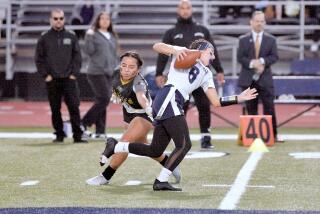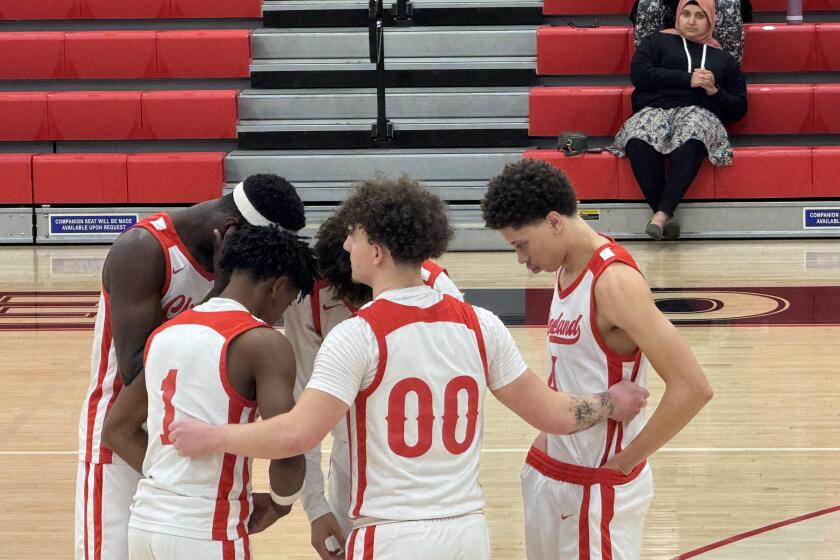Auto Achievers
- Share via
POMONA — For 22 sweaty minutes, Agoura High School seniors Etienne Allen and David Gavrilovic grappled with oxygen sensors, fuel injectors and on-board computers.
But neither lost sight of the fact that they were under the hood of a Ford Escort, not the space shuttle.
“They call us auto technicians now because there’s so much technology, but we’re all mechanics at heart,” Gavrilovic said.
“Yeah,” Allen added. “I let people call me grease monkey.”
The pair turned in the first flawless car at Friday’s state finals of the 1997 Ford/AAA Student Auto Skills National Quality Care Challenge, but finished second according to the event’s comprehensive scoring system. One of two teams from San Luis Obispo High School took top honors and will represent the state at the national competition in Washington, D.C., June 16.
Two North Hollywood High students also took part in the event at Pomona Raceway, which featured 15 two-person teams from high schools in the southern half of California racing to fix 12 identical mechanical flaws. North Hollywood High came in eighth, Anaheim’s Magnolia High School placed 12th, and Don Bosco Tech of Rosemead wound up 14th.
As they waited for the rest of the field to finish, the Agoura students worked off adrenaline from the morning, recalling how they decided by intuition to adjust the idle and replace a small metal tab missing from the taillight assembly. Their total time, including results from a written qualifying exam in March, was 42 minutes 42 seconds. San Luis Obispo finished in 40:57, a far cry from the all-time best of about 13 minutes.
“I saw that we had [electrical] power and we didn’t have to mess with the fuel line and I was all, ‘Oh yeah!’ ” Allen enthused to instructor John Andersen.
Andersen responded with a high five.
Technicians from Ford and the Automobile Club of Southern California brought 15 factory-new Escorts to the drag strip and rigged each with 12 “bugs,” from faulty fuses to improperly connected wires.
“There were a lot of hidden things,” Allen said. “You can’t really practice for this stuff, because at school you usually know what’s wrong before you go in and try to fix it.”
At the starting gun, students wearing goggles scurried around their cars, running back and forth from tables full of tools.
“First of all, you have to get it to crank,” Marvin Grande of the North Hollywood team explained before the frenzy began.
Other teams seemed to employ Grande’s strategy, some revving the engines loud enough to almost compete with the drone of a Formula One-style race for juniors happening a few hundred yards away.
Although they fell short of the top prize--a $3,000 scholarship to a Ford training program that leads to a two-year associate degree--most of the L.A.-area participants are eyeing a similar route. They are drawn by growing industry need, illustrated by an Auto Club statistic that there is one technician for every 142 cars today, compared with one per 73 cars in 1950.
“These kids are so focused,” said North Hollywood instructor Russ Mukai, who accompanied his students to the Pomona Raceway. “It’s not like they get to college and say, ‘What should I major in?’ They know.”
As skilled as they become in diagnosing the newest vehicles, many students retain a deep appreciation for less cutting-edge transportation.
“I have a ’63 Cadillac,” Allen said with a proud smile. “Those older cars have so much more personality than these bubble cars. This [Escort] could probably fit in my trunk.”
Gavrilovic added: “You’re looking at all mechanical parts, no computers. You just pull out the rag and go to work.”
More to Read
Get our high school sports newsletter
Prep Rally is devoted to the SoCal high school sports experience, bringing you scores, stories and a behind-the-scenes look at what makes prep sports so popular.
You may occasionally receive promotional content from the Los Angeles Times.






